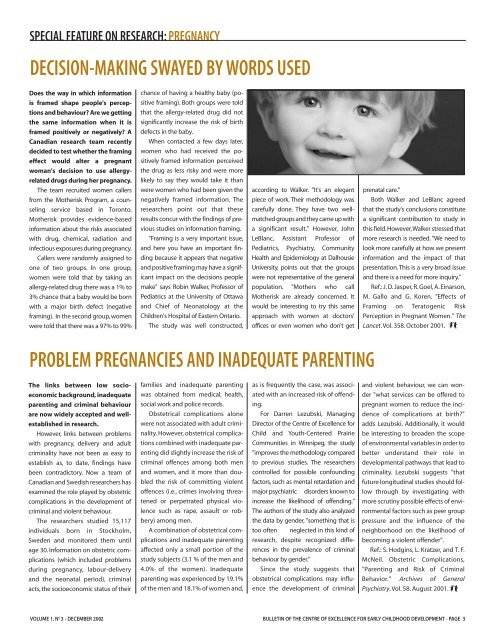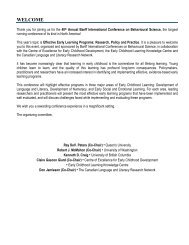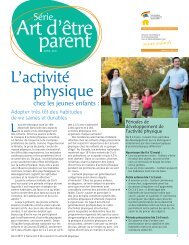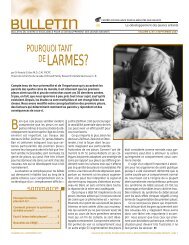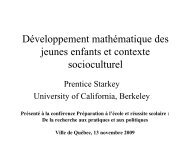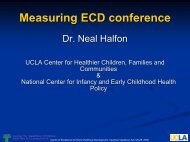Bulletin - The measure of excellence : Canadian early childhood ...
Bulletin - The measure of excellence : Canadian early childhood ...
Bulletin - The measure of excellence : Canadian early childhood ...
You also want an ePaper? Increase the reach of your titles
YUMPU automatically turns print PDFs into web optimized ePapers that Google loves.
SPECIAL FEATURE ON RESEARCH: PREGNANCYDECISION-MAKING SWAYED BY WORDS USEDDoes the way in which informationis framed shape people's perceptionsand behaviour? Are we gettingthe same information when it isframed positively or negatively? A<strong>Canadian</strong> research team recentlydecided to test whether the framingeffect would alter a pregnantwoman's decision to use allergyrelateddrugs during her pregnancy.<strong>The</strong> team recruited women callersfrom the Motherisk Program, a counselingservice based in Toronto.Motherisk provides evidence-basedinformation about the risks associatedwith drug, chemical, radiation andinfectious exposures during pregnancy.Callers were randomly assigned toone <strong>of</strong> two groups. In one group,women were told that by taking anallergy-related drug there was a 1% to3% chance that a baby would be bornwith a major birth defect (negativeframing). In the second group, womenwere told that there was a 97% to 99%chance <strong>of</strong> having a healthy baby (positiveframing). Both groups were toldthat the allergy-related drug did notsignificantly increase the risk <strong>of</strong> birthdefects in the baby.When contacted a few days later,women who had received the positivelyframed information perceivedthe drug as less risky and were morelikely to say they would take it thanwere women who had been given thenegatively framed information. <strong>The</strong>researchers point out that theseresults concur with the findings <strong>of</strong> previousstudies on information framing."Framing is a very important issue,and here you have an important findingbecause it appears that negativeand positive framing may have a significantimpact on the decisions peoplemake" says Robin Walker, Pr<strong>of</strong>essor <strong>of</strong>Pediatrics at the University <strong>of</strong> Ottawaand Chief <strong>of</strong> Neonatology at theChildren's Hospital <strong>of</strong> Eastern Ontario.<strong>The</strong> study was well constructed,according to Walker. "It's an elegantpiece <strong>of</strong> work. <strong>The</strong>ir methodology wascarefully done. <strong>The</strong>y have two wellmatchedgroups and they came up witha significant result." However, JohnLeBlanc, Assistant Pr<strong>of</strong>essor <strong>of</strong>Pediatrics, Psychiatry, CommunityHealth and Epidemiology at DalhousieUniversity, points out that the groupswere not representative <strong>of</strong> the generalpopulation. "Mothers who callMotherisk are already concerned. Itwould be interesting to try this sameapproach with women at doctors'<strong>of</strong>fices or even women who don't getprenatal care."Both Walker and LeBlanc agreedthat the study's conclusions constitutea significant contribution to study inthis field.However,Walker stressed thatmore research is needed. "We need tolook more carefully at how we presentinformation and the impact <strong>of</strong> thatpresentation. This is a very broad issueand there is a need for more inquiry."Ref.: J. D. Jasper, R. Goel, A. Einarson,M. Gallo and G. Koren. "Effects <strong>of</strong>Framing on Teratogenic RiskPerception in Pregnant Women." <strong>The</strong>Lancet. Vol. 358. October 2001.PROBLEM PREGNANCIES AND INADEQUATE PARENTING<strong>The</strong> links between low socioeconomicbackground, inadequateparenting and criminal behaviourare now widely accepted and wellestablishedin research.However, links between problemswith pregnancy, delivery and adultcriminality have not been as easy toestablish as, to date, findings havebeen contradictory. Now a team <strong>of</strong><strong>Canadian</strong> and Swedish researchers hasexamined the role played by obstetriccomplications in the development <strong>of</strong>criminal and violent behaviour.<strong>The</strong> researchers studied 15,117individuals born in Stockholm,Sweden and monitored them untilage 30. Information on obstetric complications(which included problemsduring pregnancy, labour-deliveryand the neonatal period), criminalacts, the socioeconomic status <strong>of</strong> theirfamilies and inadequate parentingwas obtained from medical, health,social work and police records.Obstetrical complications alonewere not associated with adult criminality.However, obstetrical complicationscombined with inadequate parentingdid slightly increase the risk <strong>of</strong>criminal <strong>of</strong>fences among both menand women, and it more than doubledthe risk <strong>of</strong> committing violent<strong>of</strong>fences (i.e., crimes involving threatenedor perpetrated physical violencesuch as rape, assault or robbery)among men.A combination <strong>of</strong> obstetrical complicationsand inadequate parentingaffected only a small portion <strong>of</strong> thestudy subjects (3.1 % <strong>of</strong> the men and4.0% <strong>of</strong> the women). Inadequateparenting was experienced by 19.1%<strong>of</strong> the men and 18.1% <strong>of</strong> women and,as is frequently the case, was associatedwith an increased risk <strong>of</strong> <strong>of</strong>fending.For Darren Lezubski, ManagingDirector <strong>of</strong> the Centre <strong>of</strong> Excellence forChild and Youth-Centered PrairieCommunities in Winnipeg, the study"improves the methodology comparedto previous studies. <strong>The</strong> researcherscontrolled for possible confoundingfactors, such as mental retardation andmajor psychiatric disorders known toincrease the likelihood <strong>of</strong> <strong>of</strong>fending."<strong>The</strong> authors <strong>of</strong> the study also analyzedthe data by gender, "something that istoo <strong>of</strong>ten neglected in this kind <strong>of</strong>research, despite recognized differencesin the prevalence <strong>of</strong> criminalbehaviour by gender."Since the study suggests thatobstetrical complications may influencethe development <strong>of</strong> criminaland violent behaviour, we can wonder"what services can be <strong>of</strong>fered topregnant women to reduce the incidence<strong>of</strong> complications at birth?"adds Lezubski. Additionally, it wouldbe interesting to broaden the scope<strong>of</strong> environmental variables in order tobetter understand their role indevelopmental pathways that lead tocriminality. Lezubski suggests "thatfuture longitudinal studies should followthrough by investigating withmore scrutiny possible effects <strong>of</strong> environmentalfactors such as peer grouppressure and the influence <strong>of</strong> theneighborhood on the likelihood <strong>of</strong>becoming a violent <strong>of</strong>fender".Ref.:S.Hodgins,L.Kratzer,and T.F.McNeil. Obstetric Complications,"Parenting and Risk <strong>of</strong> CriminalBehavior." Archives <strong>of</strong> GeneralPsychiatry. Vol. 58. August 2001.VOLUME 1, N O 3 - DECEMBER 2002 BULLETIN OF THE CENTRE OF EXCELLENCE FOR EARLY CHILDHOOD DEVELOPMENT - PAGE 3


